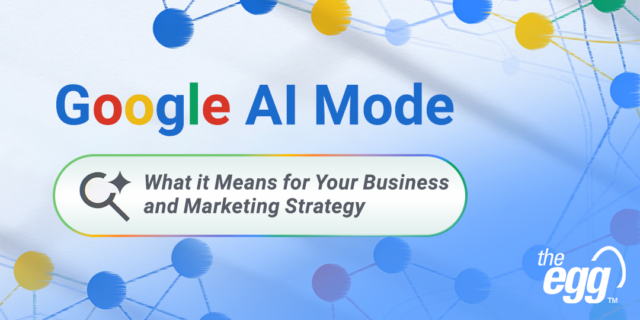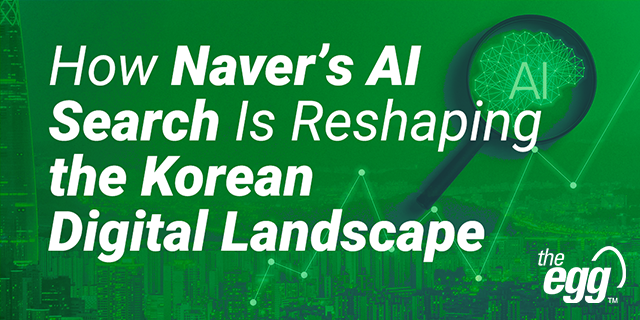Google AI Mode is Here: What it Means for Your Business and Marketing Strategy
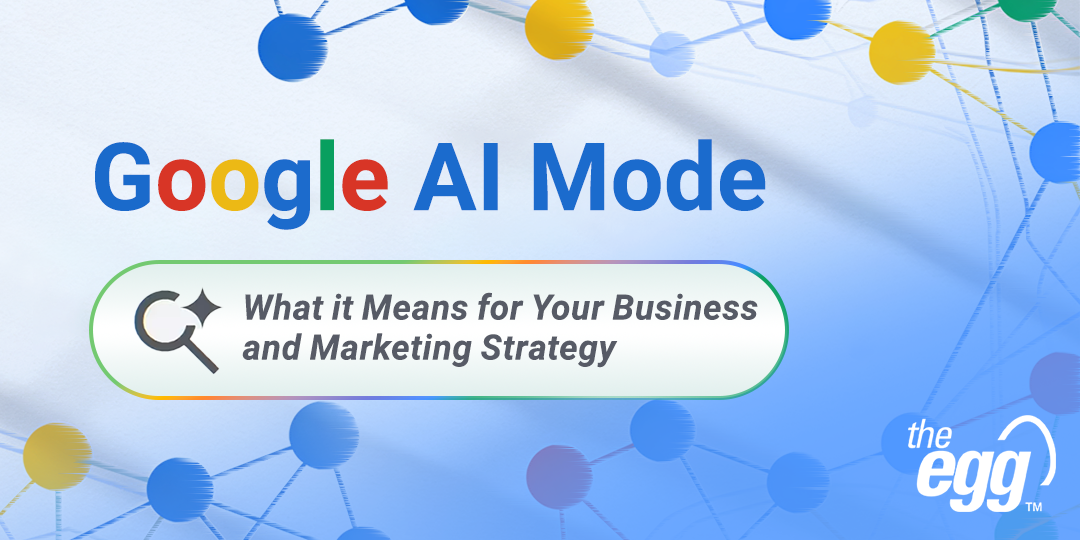
Last updated: September 16, 2025
The age of the simple keyword search is over. With the global expansion of Google’s AI Mode, search behaviour is evolving towards natural, conversational interactions that deliver immediate and personalised results. This shift is not just an update; it is a fundamental transformation of the search landscape.
On August 21, 2025, Google expanded AI Mode globally to 180 countries in English. By September 8, 2025, five additional languages were added: Hindi, Indonesian, Japanese, Korean, and Brazilian Portuguese.
This expansion accelerates AI adoption and creates new opportunities for businesses worldwide. Early feedback shows that AI Mode is already delivering more accurate and nuanced results than AI Overviews, positioning it to become the preferred search experience.
In this article, we will explore AI Mode, its impact on search, businesses, and marketers, and provide 9 actionable strategies to stay competitive.
Key Updates:
- Global Expansion: AI Mode is now available in 180 countries.
- Language Expansion: AI Mode added Hindi, Indonesian, Japanese, Korean, and Brazilian Portuguese globally.
- Agentic & Multimodal Capabilities: Handles tasks, visual summaries, and text, voice, and image inputs.
- Personalised Journeys: Results tailored to user context, history, and preferences with proactive recommendations.
These updates signal a shift in how users interact with search and highlight the need for businesses to create localised, AI-optimised content.
Understanding Google AI Mode
What is AI Mode
Google AI Mode is an advanced AI-powered search platform that delivers complex, context-aware responses, helping users complete tasks directly within search. Unlike traditional search or AI Overviews, AI Mode can handle multimodal queries across text, voice, and images, and access authorised app data to provide personalised, actionable results.
Think of AI Mode as a search companion that provides answers along with actionable next steps. While some advanced agentic features, like making bookings, are currently limited to US AI Ultra subscribers, the global rollout shows where search is heading.
AI Mode’s Key Features
- Agentic Features: AI acts on behalf of users to complete tasks like bookings or reservations. (Why it matters: Brands can appear in actionable search results, enabling direct engagement.)
- Multimodal Capabilities: Handles text, voice, and images for richer responses. (Why it matters: Businesses must optimise content across multiple formats, including visuals and structured data.)
- Personalisation: Results are personalised to each user’s history, preferences, and context. (Why it matters: Marketers can deliver highly relevant, user-specific content that increases engagement.)
- Predictive Journeys: AI anticipates user needs and suggests next steps within the search flow. (Why it matters: Brands can guide decision-making earlier, improving conversion opportunities.)
Key Differences from AI Overviews
- Brand Visibility: AI Mode features brands in about 90% of answers, surfacing 3.8X more unique brands, while AI Overviews show brands in only 43% of cases.
- How Answers are Gathered: The AI Overview provides quick summaries from traditional search sources, while AI Mode uses a “query fan-out” approach, drawing on broader, real-time, or personalised data to deliver interactive, conversational answers.
- Citations: AI Mode typically references 5-7 source cards, while AI Overviews provide over 20 inline citations per response.
- Consistency and Influence: AI Overviews are fast shifting and more volatile, making them harder to influence. AI Mode is generally more stable and predictable, which is friendlier for brand strategy, though studies show it can still exhibit high volatility for certain queries.
Why does it matter for businesses and marketers?
- Enhanced Visibility: Brands can appear in high-visibility, authoritative AI results, reaching users earlier in the decision journey and strengthening brand recall.
- Actionable Results: AI Mode suggests next steps, like bookings, recommendations, or local services, helping businesses capture and convert demand more quickly.
- Optimised Content Opportunity: To be mentioned and cited by AI Mode, businesses need structured, contextual, and up-to-date content that aligns with user intent, ensuring stronger visibility over time.
- Predictive Advantage: With personalisation and predictive journeys, AI Mode anticipates user needs, allowing brands to influence decisions across multiple touchpoints.
Ready to stay ahead of the curve?
Case Study: Testing AI Mode with a Hypothetical Client
To understand AI Mode’s capabilities for small businesses, I created a hypothetical client prompt:
“Find a marketing agency in Singapore that specialises in social media and influencer marketing for food-based home businesses. My goal is to boost brand awareness and sales for my home-based smoothie business with a limited budget.”
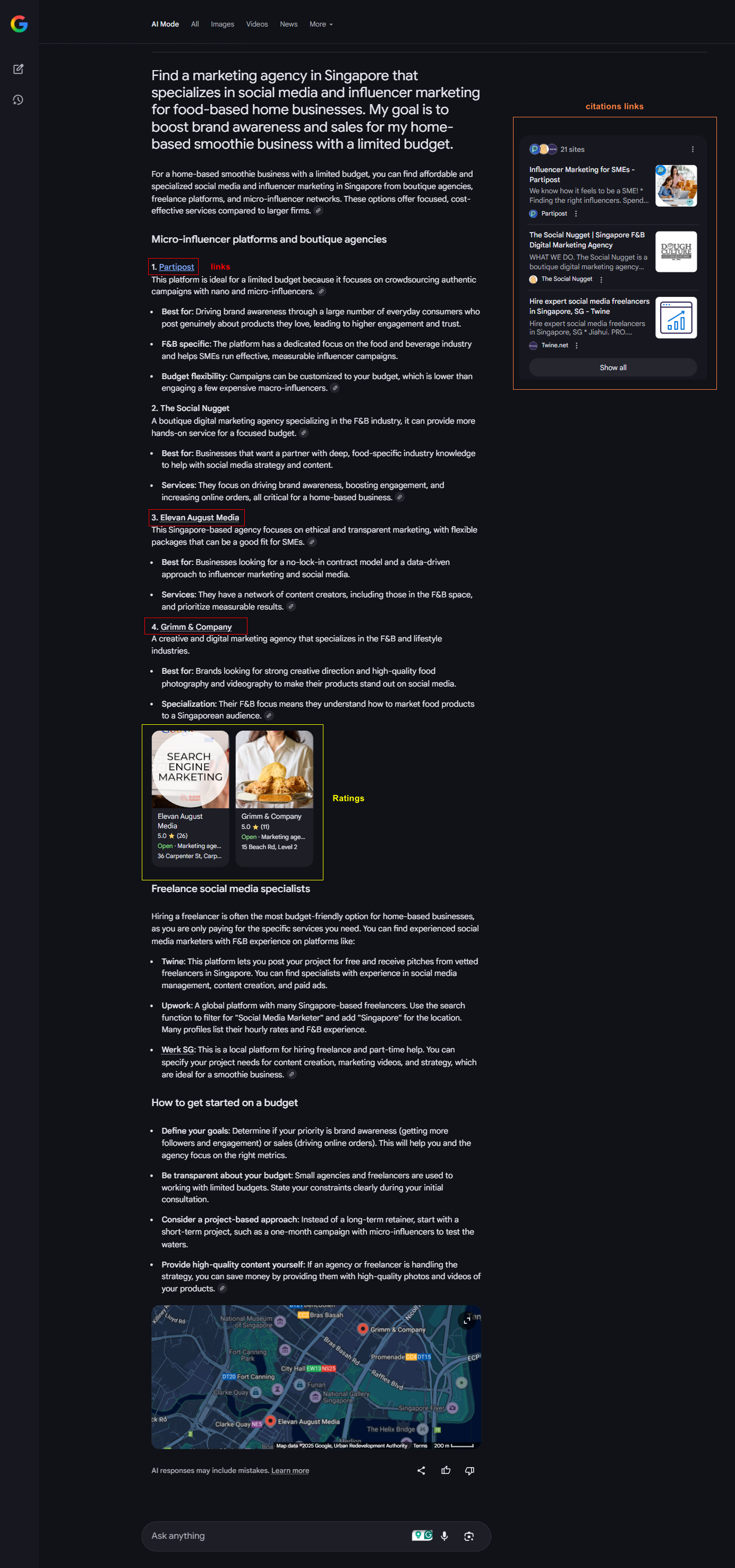
AI Mode Results:
- Curated agency list with direct links, ratings, reviews, and service summaries.
- Google Maps for easy navigation.
- Budget-friendly strategies like Instagram, user-generated content, and local networks.
- Suggested additional or alternative options tailored for small businesses on a tight budget, including actionable guidance.
For a comparative analysis, I also ran the same prompt through ChatGPT:
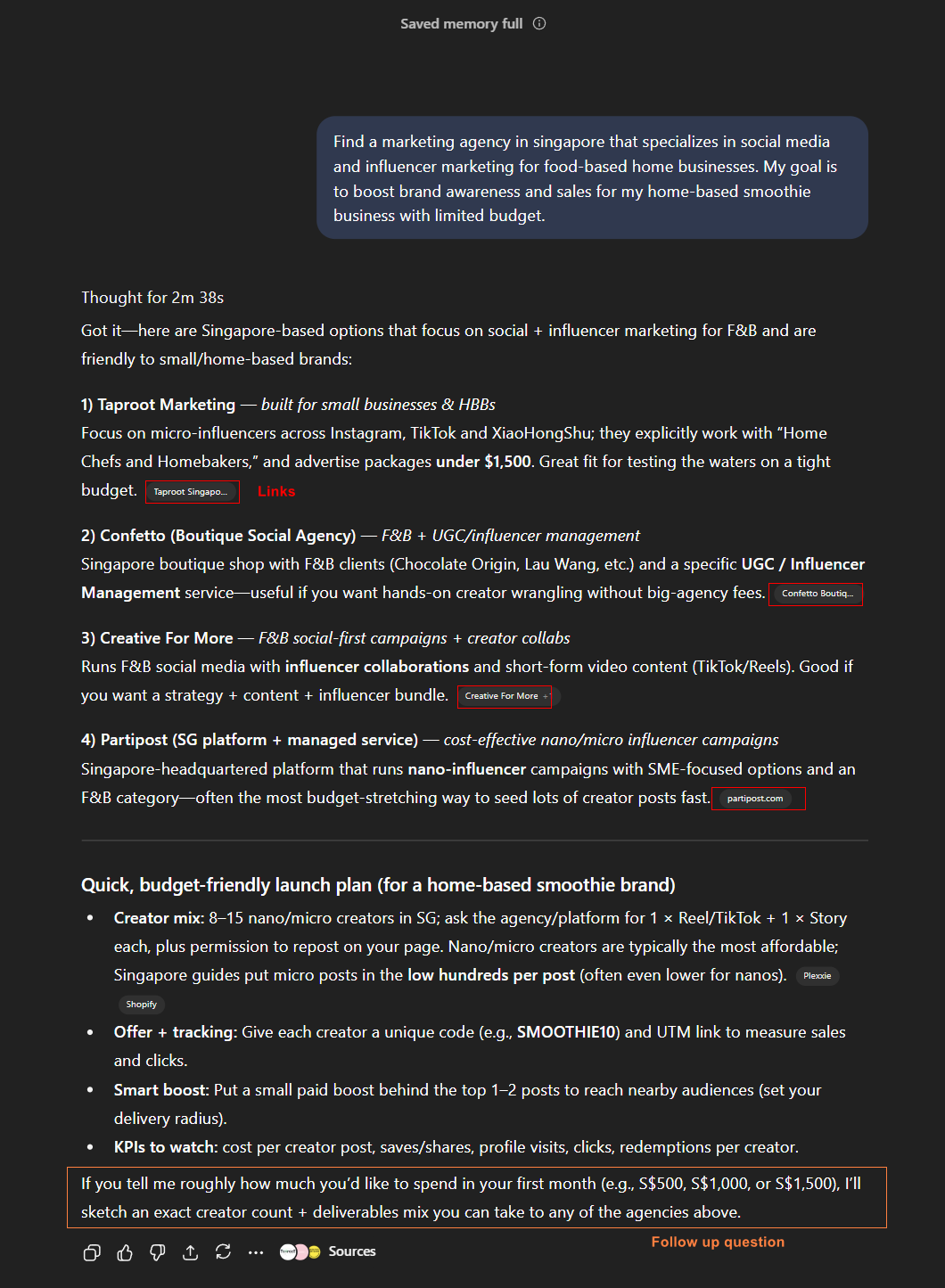
ChatGPT Results:
- AI Mode was much faster. ChatGPT took over two minutes.
- ChatGPT provided a concise, useful agency list with packages and client examples, but lacked ratings and reviews, so credibility was harder to assess.
- Suggested a quick, budget-friendly launch plan, though this approach may be more launch-specific than necessary.
- Asked for an approximate budget to provide personalised guidance, giving a more guided and conversational feel than AI Mode.
Comparative Summary: While ChatGPT provided useful and actionable strategic ideas in a more conversational and interactive way, AI Mode still showed a clear advantage. Its faster results, curated agency lists with direct links, ratings, reviews, and actionable strategies make it more practical and trustworthy for business owners, delivering concrete next steps. However, AI Mode could enhance its conversational aspect by including follow-up questions to better guide users.
How AI Mode Impacts Search
Shift in Search Experience
- Users get direct answers in search results instead of clicking through multiple websites.
- Traditional SEO traffic may decrease as AI surfaces information in-platform.
- To perform well in AI results, content must be structured for clear, actionable answers.
Brand & Topical Authority
- AI Mode favours authoritative content that demonstrates expertise.
- Brands cited directly in AI answers gain stronger visibility and credibility.
- Structured data and comprehensive content increase the likelihood of being mentioned and/or cited.
Content Funnel Adjustments
- Top-of-Funnel (informational) queries are increasingly satisfied directly within AI summaries.
- Businesses should strengthen mid and bottom-funnel content to drive conversions, since these queries are less likely to be fully resolved by AI summaries.
- Marketers need to create trusted, well-structured, and comprehensive content that supports decision-making and prompts actionable next steps.
Opportunities for Marketers
- Enhanced Visibility: When brands are cited in Google AI Mode, they gain brand presence even without clicks, boosting top-of-funnel awareness.
- Personalised Engagement: Google AI’s Mode tailored recommendations give marketers a chance to align content more closely with user intent, driving relevance and loyalty.
- Shorter Purchase Paths: Users can book, compare, or inquire directly within search, meaning marketers can capture conversions faster by ensuring product details and CTAs are optimised.
- New Ad Formats: AI-powered ad placements are emerging, creating fresh opportunities for interactive campaigns that integrate naturally into the search journey.
Research shows that appearing in AI-powered answers does not cannibalise Google Search and instead provides an additional pathway for discovery and engagement.
Challenges Businesses Must Prepare For
- Disruption of SEO Metrics: Traditional SEO metrics such as click-through rate (CTR) and organic traffic may decline as AI Mode surfaces answers directly within search results. Businesses may see fewer clicks to their sites even if visibility remains high.
- Tracking Limitations: AI interactions blend with other data, making it harder to accurately track performance and measure ROI. Marketers will need to explore new ways to monitor AI-driven visibility and engagement.
- Reduced Control: AI-generated summaries mean businesses have less direct control over their content’s presentation and contextualization. This includes uncertainty regarding which other sources or competitors might be summarized alongside their information, how their content will be distilled by AI, and whether the AI’s summary accurately reflects their intended message or brand voice. Marketers must adapt to a landscape where their content’s presentation is increasingly mediated by AI systems.
9 Actionable Strategies for Businesses & Marketers
- AI-Centric SEO & Visibility: Focus on AI search engine optimisation and start tracking impressions, AI visibility, brand presence, and topic authority, not just traditional traffic metrics.
- Cultivate Topical Authority: Become a trusted source in your niche by consistently producing solution-driven, authoritative and up-to-date content to directly answer user intent across text, voice, and visual formats.
- Understand Audience Behaviour: Analyse how users ask questions, interact across platforms, and engage with AI-generated content to inform your content and keyword strategies.
- Cross-Channel Alignment: Align messaging across social, email, and paid campaigns, ensuring brand consistency and reinforcing authority.
- Enhance Structured Data: Implement structured data (FAQ, Product, how-to schemas, etc.), and content including using clear headings, concise sentences to help AI Mode understand, categorise, and surface your content effectively.
- Localisation & Multilingual Optimisation: Adapt content for different languages, cultures, and regional search intent to capitalise on AI Mode’s global expansion.
- Monitor and Integrate Emerging AI Formats: Test AI-powered ads and conversational organic strategies, exploring formats and campaign types, such as Performance Max and AI Max, for improved intent matching.
- Continuous Testing & Experimentation: Regularly test prompts, query phrasing, and content formats to see how AI Mode surfaces your brand and refine your strategy quickly.
- Work With Early Adopters of AI: Collaborate with AI-savvy marketers and agencies who have embraced the technology for data analysis, trend prediction, and marketing reports, including brand visibility and sentiment tracking.
Conclusion: Embrace the AI Mode Era
Google AI Mode is still in its early stages, but it signals a seismic shift in how brands are discovered and connect with consumers. Businesses that embrace AI-centric strategies, prioritise authority and utility, and adapt to new forms of visibility will lead in the AI-driven search landscape.


